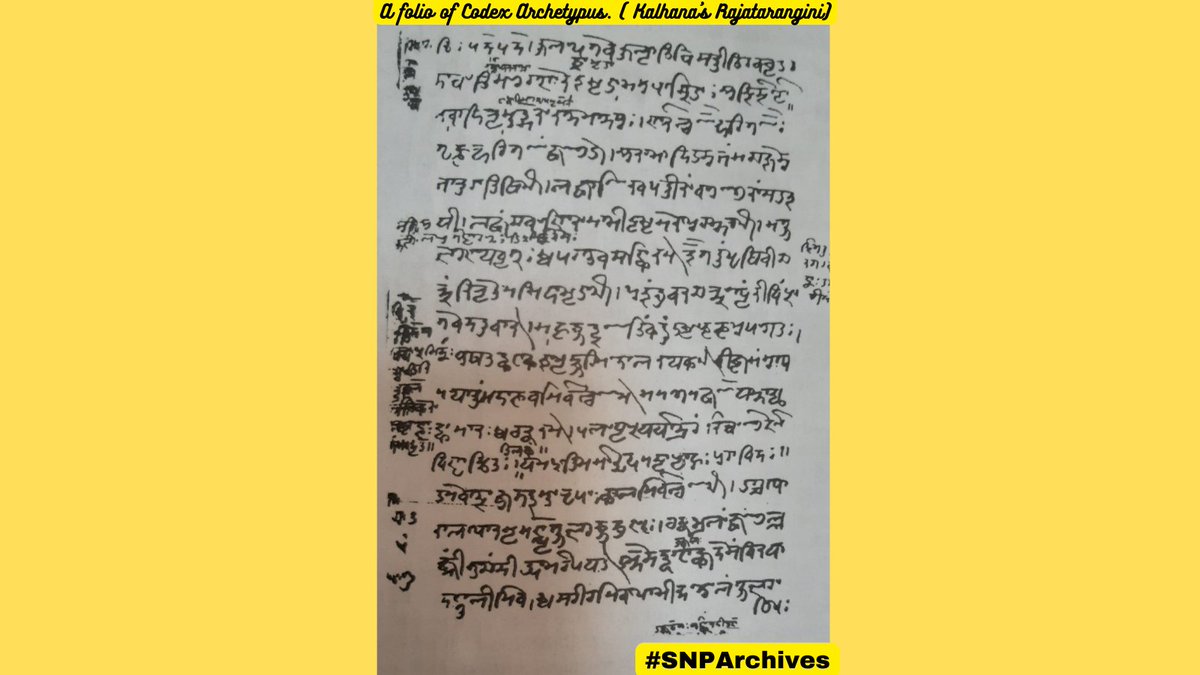
India's oldest written history Rajatarangini - The Ancient Political History of Kashmir.
A thread...
#Rajatarangini was authored by a Kashmiri Brahmin named Pandit Kalhana. Written in the 12th century, (1/11)
A thread...
#Rajatarangini was authored by a Kashmiri Brahmin named Pandit Kalhana. Written in the 12th century, (1/11)

its original manuscript called Codex Archetypus was a heirloom of single family for 9 generations. The seventh descendant was the famed #Saivite Sivopdhyaya. (2/11)
Written on paper in #sarada script in the hand of the far famed scholar and copyist Rattanakantha Popularly called Ratha Razdan for his fast writing and cursive handwriting difficult to read, (3/11)
The Codex was first located in 1875 by #Buhler with Pandit Sivopadhyaya's son Pandit Kesavram. The owner allowed him a mere glance and denied any touch to it. 13 years later his pupil #Stein re- located it in Kashmir in 1888. The manuscript, however, (4/11)
was now split among the three sons of Kesavram. The new owners maintained the policy of their father not to part away with their respective portions. Skilled negotiations and artful diplomacy duly supported by Pandit Suraj Kaul, (5/11)
the manuscript was nearly lost in the sea while Stein was returning from England in 1890 after having shown the unique manuscript to his illustrious teacher #Buhler in Vienna. Fortunately, the corrosive sea water did not effect the ink and the paper of the manuscript. (7/11) 

After preparing its copy for use in the printed edition, Stein returned all the three original parts to the respective owners in 1892. However, since that time no one knows the fate of the Codex Archetypus. Is it lost or preserved? Any clues are welcome. (8/11) 

But do not search for the original manuscript written on the #birchbark. There is no hope for its existence. It was thrown in the River Vitasta during the harsh Pathan rule at the beginning of the 19th century. At the time, (9/11)
it was customary for the native #Pandits to consign sacred objects to the river in order to prevent their defilement at the hands of brute zealots. (10/11)
#TuJantaHeKyaHaiKashmirKeBareMai (11/11)
@bodleianlibs @UniofOxford @nirupamakotru @MattLaemon @Dilleye @SrinagarGirl @mysticsrishti @Kashmirinmycup @Rolee_Kachru @hansmukhi @misskaul @sidkakspeaks @ManMohini2 @siddharthagigoo @searchkashmir @bhashasumbli @shivanibazaz
@bodleianlibs @UniofOxford @nirupamakotru @MattLaemon @Dilleye @SrinagarGirl @mysticsrishti @Kashmirinmycup @Rolee_Kachru @hansmukhi @misskaul @sidkakspeaks @ManMohini2 @siddharthagigoo @searchkashmir @bhashasumbli @shivanibazaz

@ARanganathan72 @AnupamPKher @KashmirFiles @vivekagnihotri @DarshanKumaar @hvgoenka @saurabhtop @TheLallantop @8ate @Nidhi @dkandathil @shardapeetham @srkngo @JandKTourism @AdityaRajKaul @surinderkauldr @kp_global @virsanghvi @ashokepandit. aapka feedback? 

@threadreaderapp - unroll pls
• • •
Missing some Tweet in this thread? You can try to
force a refresh






